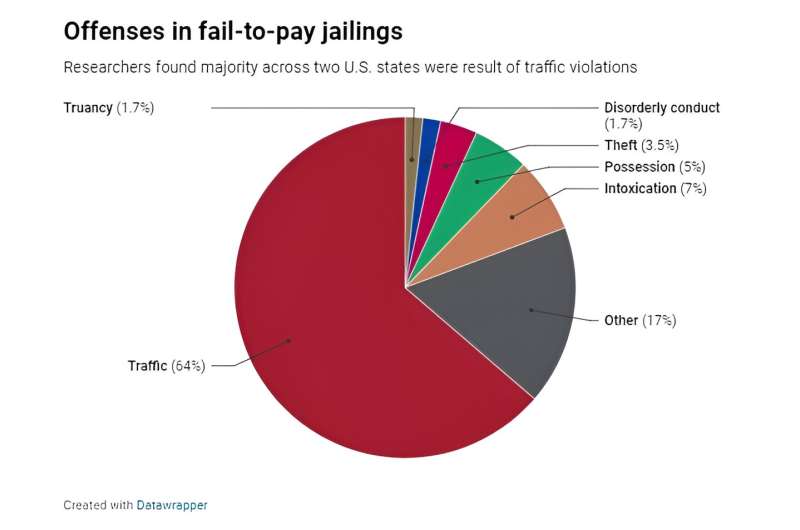This article has been reviewed according to Science X's editorial process and policies. Editors have highlighted the following attributes while ensuring the content's credibility:
fact-checked
peer-reviewed publication
trusted source
proofread
How common is debt imprisonment in the US today?

Imprisonment for unpaid debts might seem Dickensian, a relic of harsher times. But thousands of people serve jail time each year in the U.S. for failure to pay fines, fees, and other court costs, often resulting from lower-level violations such as traffic tickets.
Harvard researchers have brought attention to the plight of such debtors in a new paper, "Forgotten But Not Gone: a Multi-state Analysis of Modern-Day Debt Imprisonment," published in PLOS ONE. Theirs is a first attempt to quantify the magnitude and prevalence of imprisonments for court debts in the U.S., for which no standardized record-keeping exists.
First author and statistics graduate student Johann Gaebler first became aware of debt imprisonment while an intern at the American Civil Liberties Union in Wisconsin, just after graduating from the College in 2017 with a degree in mathematics.
"I didn't even realize that this existed in the American legal system—that there are still mechanisms for jailing people for unpaid court debts," said the Griffin Graduate School of Arts and Sciences student. "And it felt like nobody really knew what was going on—even at the state level, to say nothing of the national level—because there was no integrated data."
Gaebler started the project while working at the Computational Policy Lab run by Sharad Goel, now a faculty member at the Harvard Kennedy School of Government. With Goel and journalists Phoebe Barghouty and Cheryl Phillips of the Stanford Computational Journalism Lab, he culled data from millions of records collected through hundreds of public records requests to county jails to produce their first-of-its-kind dataset.
Over about four years, they collected and standardized the records of more than 4 million jail bookings and almost 3 million court cases. Stanford economics graduate student Sarah Vicol rounded out the team.
The data presented an order-of-magnitude estimate of the prevalence of debt imprisonment in specific states: Between 2005 and 2018, Texas courts jailed people for failure to pay around 38,000 times per year, and Wisconsin courts around 8,000 times per year, with the median time served being one day in jail in both states.
They also looked at court debt data in Oklahoma, finding that unpaid fines and fees leading to imprisonment came most commonly from traffic offenses, for which a typical Oklahoma court debtors owes around $250, or $500 if an arrest warrant is issued.
Their data-gathering included case studies of individuals. "Ms. Smith," a Black woman from Austin, Texas, spent a night in jail in 2017 after several years of unpaid traffic citations and an arrest for failure to pay. Her jailing, the researchers wrote, represents an extreme example of what some researchers have termed "criminalization of poverty." These are ways in which the American criminal justice system metes punishments through mechanisms that disproportionately affect poor people, such as cash bail, fines, and fees related to court appearances.
At the outset, the project felt unusual for academic research, even for Gaebler, who has worked on other projects that apply a statistical lens to issues of social justice and policy. "It didn't involve fancy estimation or a clever scientific idea. It really was just, "Here's a really important thing that, unfortunately, takes a huge amount of work to measure.'"
Imprisonment for debt "feels like something that shouldn't happen anymore," Gaebler said. Their analysis highlights that some states, like Colorado, have eliminated the practice of issuing failure-to-pay warrants—so change is possible.
The researchers hope their analysis sparks conversation and enables other researchers or policymakers to better understand debt imprisonment within individual communities. They've made their data publicly available.
More information: Johann D. Gaebler et al, Forgotten but not gone: A multi-state analysis of modern-day debt imprisonment, PLOS ONE (2023). DOI: 10.1371/journal.pone.0290397
Journal information: PLoS ONE
Provided by Harvard University
This story is published courtesy of the Harvard Gazette, Harvard University's official newspaper. For additional university news, visit Harvard.edu.





















